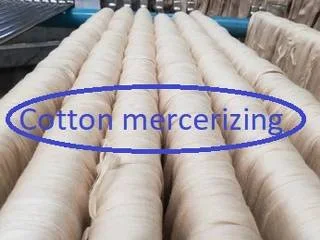Mercerizing
Mercerizing
is the process of treating cellulosic elements with cold or hot caustic
conditions to improve their appearance and physical as well as chemical
properties under certain conditions. In simple words, the process of treating
caustic alkali under pressure for increasing color, strength, and luster. It is
sometimes known as pearl cotton.
Specially
mercerization is a process to get the desired luster and tensile strength,
cotton is held under 55–65 ° Twaddell scale tension for about ten minutes with
an application of between 21%-23% caustic soda, and wetting agents that are
used to facilitate the transfer of the NaOH into the fibers, at room
temperature. Then the fabric is neutralized by an acid bath.
This process is done after the bleaching operation. Although bleaching is enough for
preparing the fabrics for dyeing and printing but mercerizing is done for adding
some advantage to the fabric. The luster and strength of the fabric increase
after the mercerizing process.
Objectives of the mercerizing process
i.
To improve the luster of cotton materials
ii.
To increase the ability to absorb dye and moisture of the cotton
iii.
To improve reactions with a variety of chemicals for different stages
iv.
To improve the dimensional stability of materials
v.
To improve strength elongation and mechanical properties of the cotton
vi.
To improve the smoothness of the cotton
vii.
To improve the hand feel of the cotton product
Mechanism of Mercerizing process
A.
Maximum swelling in a particular range of alkali concentration is the result of
-
i. the attraction of alkali-cellulose on the one
hand and
ii. the remaining free alkali on the other.
B.
Hydration of cellulose increases with increasing stability of alkalis in
solutions of increasing concentration up to a certain limit.
C.
After which free alkali exerts a dehydrating effect on the alkali-cellulose to
a great extent.
Steps of the mercerizing finishing process
i.
Pre-tensioning is the first step of the yarn mercerizing finishing process, which is driven
to distribute the Greig yarn hunks evenly across the rollers without mixing
with the opposite direction of motion of the rollers. In this step, the
material should be completely wet.
ii.
Shrinkage is the original caustic treatment step or mercerizing step where the
yarn is allowed to shrink freely, the yarn reacts fully with the caustic for a
sufficient period of time, Mercerizing will be further improved as a result of
the shrinkage.
iii.
Lye tensioning is done to stretch the yarn back to its original length.
iv.
Squeezing is done to remove the unbound caustic solution from the material so
that the material can be washed effectively and the caustic material can be
reduced quickly. This measure also ensures to reduction the wastage of excess
caustic liquor during washing.
v.
Washing and tensioning are the stages where the stretch is applied to get the
maximum luster, the material is washed with extensions outside its original
length to produce better luster. The amount of stretch applied depends on the
required luster and yarn quality. The washing temperature is kept close to a
boil so that the washing can be efficient and minimal. The time or wash
sequence is so adjusted to reach a residual caustic material below 10% in a
very short time.
vi.
The final caustic content should be below 10% because if it is too high it will
be enough to run a more mercerizing effect and the material will shrink
backward. When storing mercerized material, water will evaporate from the
exposed area and cause a locally concentrated effect, which is called local
mercerizing and will lead to patchy dyeing. The level of residual caustic in
the yarn is achieved less than 3%, if it is on the higher side, washing is not
effective.










0 Comments